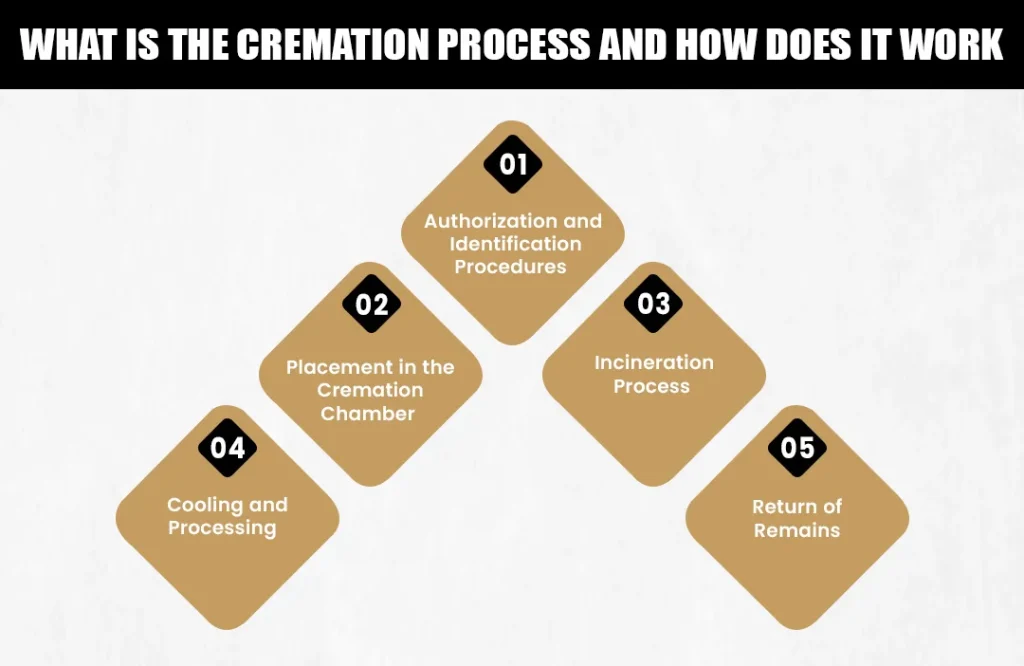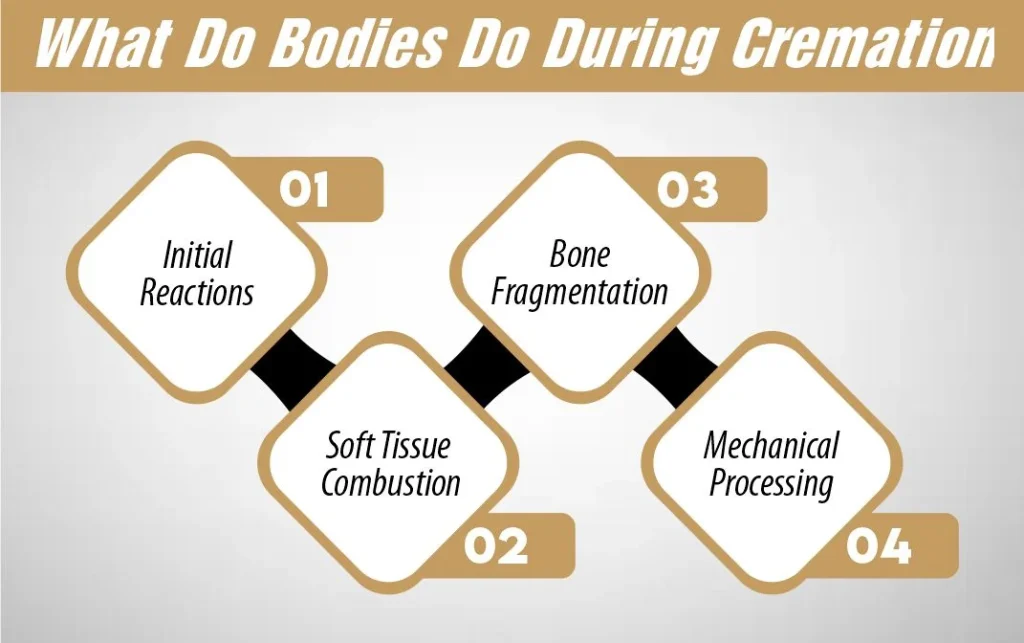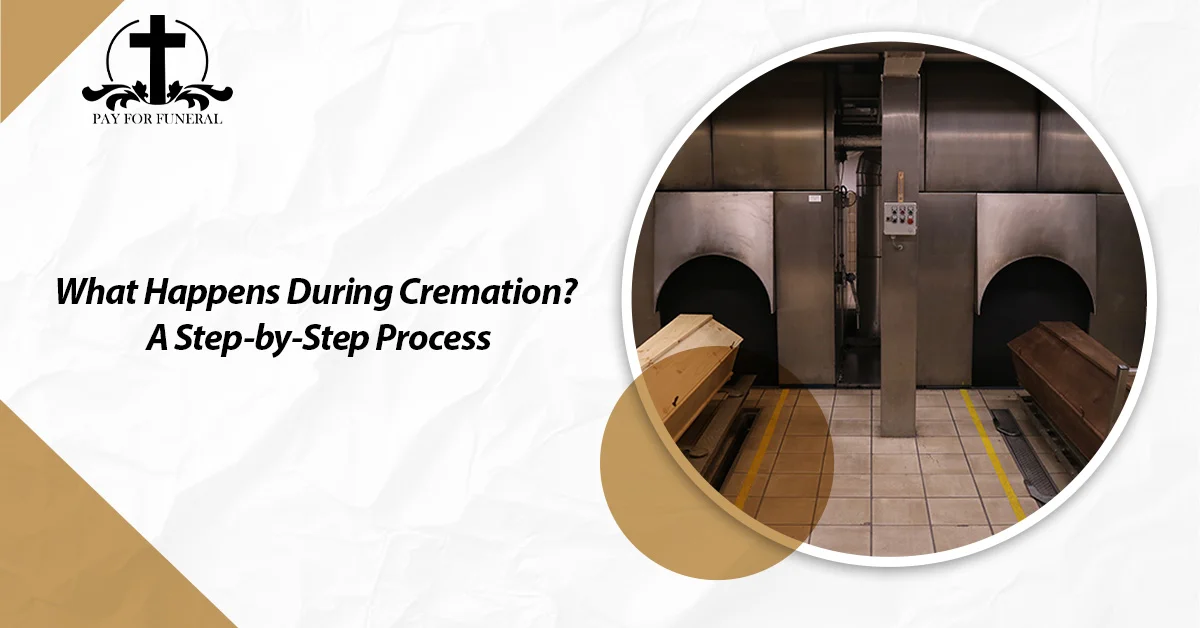Introduction
Cremation is a widely chosen method for final disposition, yet many people are unfamiliar with what actually happens during the process. From the moment a body enters the crematory to the return of the ashes, cremation is a precise and carefully regulated procedure, one that’s often misunderstood or surrounded by mystery.
In this article, we’ll walk you through each step of the cremation process, explaining how it works and what to expect. We’ll also uncover lesser-known facts, such as how long cremation takes, which parts of the body don’t burn, and even some of the more somber realities behind the practice.
Whether you’re planning ahead, supporting a loved one, or simply curious, this guide offers honest and respectful answers to your questions about cremation.
What Is the Cremation Process and How Does It Work?
Cremation is a dignified and regulated process that involves several critical steps, each carefully followed to ensure both respect for the deceased and safety throughout the procedure. Let’s break down the key stages of the cremation process, from authorization to the return of ashes.
Get Free Quotes
Customized Options Await
1. Authorization and Identification Procedures
Before any cremation can take place, it is crucial to obtain proper authorization. Legal documents, including a signed cremation permit, must be submitted to the crematory. The family or representative of the deceased will typically provide these documents, confirming their consent for the process.
Identification procedures are strictly enforced to ensure the right body is cremated. The crematory staff will perform multiple identification checks, often using wristbands or other forms of clear identification that remain with the body through the entire process. This ensures that the remains returned to the family are the correct ones.
2. Placement in the Cremation Chamber
Once the necessary documentation is completed and the identification confirmed, the body is prepared for cremation. The body is placed in a cremation container, often made of wood or cardboard, which is designed to safely hold the body during incineration.
The body is positioned in the cremation chamber, a specially designed oven called a retort. In the retort, the body is subjected to extremely high temperatures, typically between 1400–1800°F (760–982°C), to break down the tissue. The body is positioned in the chamber in a way that allows for optimal heat distribution and ensures the cremation process is as efficient as possible.
3. Incineration Process
The cremation process itself involves the complete incineration of the body. The temperature in the retort ranges from 1400 to 1800°F (760 to 982°C), depending on the equipment and specific protocols followed. At these temperatures, all organic material is reduced to gases, leaving only bone fragments behind.
The duration of the cremation process typically lasts 1.5 to 2.5 hours, depending on factors like the body’s size and the type of cremation chamber used. During this time, the body undergoes a transformation as the intense heat consumes organic matter, reducing the body to bone fragments.
4. Cooling and Processing
Once the cremation is complete, the remaining bone fragments are left to cool down. This cooling process can take several hours. Once cool enough to handle, the bone fragments are carefully removed from the retort.
The bone fragments are then processed. This step typically involves the use of a cremulator, a machine that crushes the bone fragments into a fine powder, resulting in what are commonly known as “ashes.” The remains are carefully sorted to ensure that no foreign materials, such as metal prosthetics, are included in the final collection.
5. Return of Remains
After the cremated remains are processed, they are placed in an urn or another container chosen by the family. These remains typically consist of bone fragments that have been ground down into a fine, sandy texture, and while the term “ashes” is commonly used, they are technically the remnants of bone.
The cremated remains are returned to the family in a respectful and secure manner, usually within 7–10 business days after the cremation. The urn or container can be delivered directly to the family’s home, or the family can choose to pick it up from the crematory.

Key Considerations
Throughout the entire cremation process, numerous standards and regulations are followed to ensure a dignified, ethical process. In North America, organizations like the Cremation Association of North America (CANA) establish and monitor industry guidelines, ensuring that each cremation is carried out with care and respect.
In summary, the cremation process is a carefully orchestrated procedure, designed to handle the body respectfully and safely. From initial authorization and identification to the careful return of the remains to the family, every step ensures that the deceased is treated with dignity, and the family receives the remains in a compassionate and secure manner.
Sources:
- Cremation Association of North America (CANA)
How Long Is the Process?
One of the most common questions families ask is: How long does cremation take? While the actual time a body spends in the cremation chamber is relatively short, the entire process from start to finish can take several hours to several days, depending on various factors.
Cremation Duration: 1.5 to 3 Hours
The incineration phase of cremation typically takes between 1.5 to 3 hours. The exact length depends on multiple factors, including:
- Body size and weight – Larger bodies generally take longer to cremate.
- Chamber temperature – Most cremation chambers operate between 1400°F and 1800°F. Higher temperatures speed up the process, but must be balanced for safety and efficiency.
- Type and age of equipment – Modern retorts are faster and more energy-efficient than older models, which may take longer.
Crematory operators monitor and control the process throughout to ensure complete and respectful combustion.
Cooling and Processing Time: 1 to 2 Hours
Once the cremation is complete, the remains still consisting of bone fragments — must cool for 30 minutes to 2 hours before they can be safely handled. After cooling, the fragments are processed into a fine powder using a specialized machine. This part of the process adds about another 30 to 60 minutes, depending on the volume and consistency of the remains.
Total Time Until Remains Are Returned
While the physical cremation itself may take just a few hours, the total time until a family receives the ashes can be longer due to:
- Waiting periods and documentation (varies by state or region)
- Scheduling (especially if the crematory is handling multiple cases)
- Urn selection or personalization requests
In general, families can expect to receive the cremated remains within 1 to 7 days, although in some cases it may be faster especially if arrangements are made in advance or expedited services are offered.
What Do Bodies Do During Cremation?
Cremation is not only a high-heat process it’s also a scientifically observable one. Many people are curious, and sometimes even uneasy, about what physically happens to a body during cremation. Let’s walk through what actually occurs inside the cremation chamber, separating fact from myth and explaining each stage in clear, respectful terms.
1. Initial Reaction:
When a body is first placed into the cremation chamber (retort), it is subjected to intense heat ranging from 1400°F to 1800°F (760°C to 982°C). One of the first visible reactions may appear like movement. However, this is not true motion or conscious activity.
What happens instead is that heat causes muscles and tendons to contract, especially in the arms and legs. This can make the body change position slightly, sometimes arching or curling. These are purely involuntary responses to temperature, similar to how meat shrinks when cooked. There is no brain activity or life-like movement. Myths suggesting the body “sits up” or “reaches out” are unfounded and scientifically inaccurate.
Fact Check: Any appearance of movement is the result of muscle and connective tissue tightening due to heat. There is no consciousness or pain involved.
2. Soft Tissue Combustion:
As temperatures rise, the body’s soft tissues, skin, fat, and organs are incinerated. This part of the process includes:
- Evaporation of water content (the human body is roughly 60% water)
- Combustion of fats and connective tissues
- Vaporization of internal organs, which disintegrate rapidly under high heat
This stage produces most of the visible flame and heat within the retort. Gases released during the process (primarily carbon dioxide and water vapor) are filtered through the crematory’s exhaust and scrubber systems to comply with environmental regulations.
3. Bone Fragmentation:
After the soft tissues are fully consumed usually after 1.5 to 2 hours what’s left are calcified bone fragments. These fragments are brittle and extremely light-colored, typically white or pale gray.
At this stage, the remains are not yet the “ashes” most people imagine. These are unrefined bone pieces, similar in texture to coarse gravel. They must be further processed before they are returned to the family.
4. Mechanical Processing:
Once the bone fragments have cooled, they are removed from the retort and placed into a device called a cremulator. This machine grinds the fragments into a fine, sand-like consistency, which is what most people recognize as cremated “ashes.”
The final cremated remains weigh about:
- 3 to 7 pounds (1.4–3.2 kg) for adults, depending on body size and bone density
These remains are then placed into a temporary container or an urn, as selected by the family.

Visual Summary of the Cremation Process:
- Initial Heat Exposure: Muscle tightening and contraction (not conscious movement)
- Soft Tissue Combustion: Skin, fat, and organs vaporize under extreme heat
- Bone Fragmentation: Only calcified bones remain
- Processing: Bones are pulverized into fine ashes
Understanding the biological and physical changes that occur during cremation helps demystify the process and can provide comfort by replacing fear or misinformation with facts. Everything is handled with care, regulation, and respect for the deceased and their loved ones.
Which Part of the Body Does Not Burn During Cremation?
A common question about cremation is whether any part of the body does not burn completely. While nearly all soft tissues are incinerated during the process, certain body parts and materials either resist complete combustion or require special handling. Here’s what you need to know.
1. Teeth and Bones: The Last to Degrade
Teeth and bones are the most durable parts of the human body and do not completely burn into ash. Instead, they calcify and fragment during the cremation process.
- Bones, after all organic matter is consumed, are reduced to brittle, porous remains. These do not turn to ash naturally; they must be mechanically processed into powder using a cremulator.
- Teeth can sometimes survive the heat but often crack, crumble, or melt depending on the temperature and duration. Molars are more likely to remain intact due to their density.
Misconception: Some believe the entire body “turns to ash.” In reality, the “ashes” are processed bone fragments, not incinerated tissue or residue from other body parts.
2. Dental Fillings and Other Restorations
Dental work such as fillings, crowns, or bridges made from metals like gold, silver, or amalgam may partially survive the cremation process. However, most are:
- Melted or vaporized depending on their composition and placement
- Removed along with other metallic residue after cremation during the final processing phase
Some materials, like amalgam fillings (which contain mercury), are regulated due to potential emissions. Crematories often have strict filtration and environmental controls to handle these safely.
3. Medical Implants: Pacemakers, Hip Replacements, and More
Implants made from metal or containing batteries are a crucial concern:
- Pacemakers must be removed before cremation due to the risk of explosion from internal batteries. Crematories are legally required to ask about and remove these devices ahead of time.
- Orthopedic implants like hip and knee replacements, surgical screws, rods, or pins are usually made from titanium or stainless steel, which do not burn or melt in typical crematory conditions.
These materials are removed after cremation and often recycled according to local laws and environmental best practices. Some crematories participate in programs that donate recycled metals to charity.
4. What Happens to Non-Organic Remains?
After the body has been cremated and cooled:
- Any metal fragments (from dental work, implants, or casket screws) are separated from the bone fragments using magnets or manual sorting.
- The metal is typically recycled in an ethical, environmentally-conscious way. Families can request information about this if they wish.
Understanding what does and doesn’t burn during cremation helps clear up misconceptions and provides insight into how thoroughly regulated and respectful the process truly is. Everything that remains organic or not is handled with care, and the final ashes returned to families are clean, processed, and free of foreign materials.
Conclusion
Cremation is a deeply personal choice, and understanding the process helps remove much of the mystery and misconception that often surrounds it. From the initial authorization and careful identification procedures, to the high-temperature incineration and respectful handling of remains, cremation is both scientifically precise and ethically regulated.
We’ve explored what physically happens to the body during cremation—how tissues break down, which parts do not burn, and how bone fragments are ultimately processed into ashes. We also addressed important concerns, such as environmental impact, rare mishandling incidents, and the emotional complexities some families may experience.
Whether you’re considering cremation for yourself as part of end-of-life planning or making decisions for a loved one, this knowledge empowers you. It allows for more confident, respectful choices that align with your values, beliefs, and emotional needs.
Cremation is not just a method of disposition, it’s a meaningful part of the farewell. By understanding what happens during cremation, we honor both the science and the sentiment behind this time-honored process.
Frequently Asked Questions
The ashes are processed bone fragments, collected after cremation and returned in an urn or container.
Any movement is due to heat-induced muscle contractions; there is no awareness or conscious motion.
Yes, bodies are usually cremated in a simple gown or clothing chosen by the family.
No, each body is cremated individually, except in rare legal exceptions like a mother and infant.
Rachel Smith, Funeral Insurance Specialist
Rachel Smith is a dedicated funeral insurance expert at Pay For Funeral, with over 10 years of experience helping families find peace of mind during life’s most sensitive moments. Known for her warm, compassionate approach, Rachel empowers individuals to plan with clarity, dignity, and confidence. She specializes in simplifying funeral insurance, making it approachable, affordable, and tailored to each person’s unique needs. Through every article she writes, Rachel strives to educate, comfort, and guide readers in making thoughtful, informed choices for the future.








